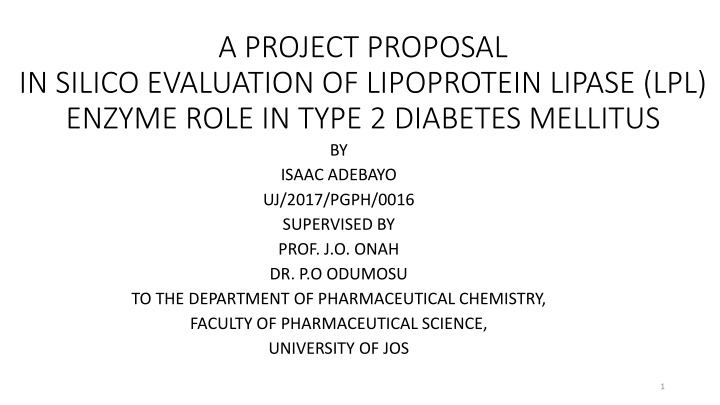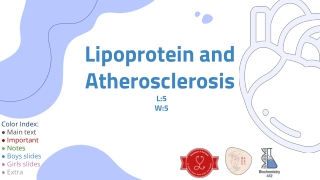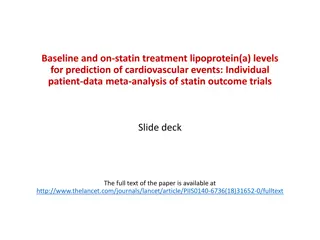In Silico Evaluation of Lipoprotein Lipase Enzyme in Type 2 Diabetes Mellitus
Lipoprotein lipase plays a crucial role in lipid metabolism and has been implicated in the pathophysiology of type 2 diabetes mellitus. This project proposal aims to evaluate the structural features, active sites, and functional groups of lipoprotein lipase to understand its involvement in the development of diabetes. Through bioinformatics tools and data analysis, the study seeks to provide insights for potential modifications to improve treatment strategies for diabetes.
Download Presentation

Please find below an Image/Link to download the presentation.
The content on the website is provided AS IS for your information and personal use only. It may not be sold, licensed, or shared on other websites without obtaining consent from the author.If you encounter any issues during the download, it is possible that the publisher has removed the file from their server.
You are allowed to download the files provided on this website for personal or commercial use, subject to the condition that they are used lawfully. All files are the property of their respective owners.
The content on the website is provided AS IS for your information and personal use only. It may not be sold, licensed, or shared on other websites without obtaining consent from the author.
E N D
Presentation Transcript
A PROJECT PROPOSAL IN SILICO EVALUATION OF LIPOPROTEIN LIPASE (LPL) ENZYME ROLE IN TYPE 2 DIABETES MELLITUS BY ISAAC ADEBAYO UJ/2017/PGPH/0016 SUPERVISED BY PROF. J.O. ONAH DR. P.O ODUMOSU TO THE DEPARTMENT OF PHARMACEUTICAL CHEMISTRY, FACULTY OF PHARMACEUTICAL SCIENCE, UNIVERSITY OF JOS 1
LIPOPROTEIN LIPASE ENZYME photo credits:journal of lipid research 2
BACKGROUND OF THE STUDY Lipoprotein lipase is a member of the lipase gene family which includes pancreatic lipase, hepatic lipase and endothelial lipase. A water soluble enzyme that hydrolyses triglycerides in lipoprotein, such as those found in chylomicrons and very low density lipoproteins into free fatty acids and one monoacylglycerol molecule as shown below. It is also involved in promoting the cellular of uptake chylomicron remnants, cholesterol-rich lipoproteins and free fatty acids.(Mead, Irvine & Ramji, 2002) Lipoprotein lipase activity is modulated by angiopoietin-like4 (Gusarova et al.,2018) 3
BACKGROUND CONTINUED LIPOPROTEIN LIPASE 4
Background continued Type 2 diabetes mellitus is a Chronic metabolic disorder that is characterized by high blood sugar, insulin resistance and relative(deficiency) lack of insulin. Common symptoms include thirst, frequent urination and unexplained weight loss, increased hunger, feeling tired and sores that do not heal. There are long time complications especially when not properly managed. Earlier work done in that direction has implicated lipoprotein lipase enzyme in the pathophysiology of type 2 diabetes mellitus. (Gusarova et al.,2018) 5
Background continued RISK FACTORS INCLUDE Over weight or obese Age of 45 and above Family history of diabetes high blood pressure Have a low level of high density lipoproteins Sedentary lifestyle 6
AIM To evaluate the structural features, active sites, key functional groups responsible for activity and role in development of Type 2 diabetes mellitus. 7
OBJECTIVE Data retrieval of lipoprotein lipase enzyme protein sequence from relevant data base like Protein data bank (PDB) Sequence annotation and visualization using Genomic tools like Aquaria, Autodesk molecule viewer software. Functional site prediction using bioinformatics software like PDBSitescan or MarkUs software. Predictions of possible modification to improve type 2 diabetes mellitus outcome. 8
Research Question Would structure, function and active site modification of lipoprotein enzyme In Silico have a role in type 2 diabetes mellitus? 9
Materials and method Materials High performance computer Good internet connection Bioinformatics softwares for sequence annotation and functional site predictions. 10
Materials and methods continued Methods Installation of necessary software for the work Data retrievals of lipoprotein lipase enzyme sequence. Sequence annotation, functional sites prediction and other possible modification possible using available softwares. 11
TIMELINE OF DISSERTATION ACTIVITY DURATION More literature review October to mid November Materials acquisition October to mid November Data retrieval Mid November to November ending In silico evaluation December to January Results Early February 12
REFERENCE REFERENECE LIST Mead, j.r., Irvine, s.a., & ramji, d.p (2002) lipoprotein lipase: structure, function, regulation and role in disease, Mol J. pp.758-769 DOI:10.1007/s00109-002-0384-9 Viktoria Gusarova et al., (2018).Genetic inactivation of ANGPTL4 improves glucose homeostasis and is associated with reduced risk of diabetes, nature communications p.1 DOI: 10.1038/s41467-018-04611-z 13
THANK YOU FOR LISTENING 14























